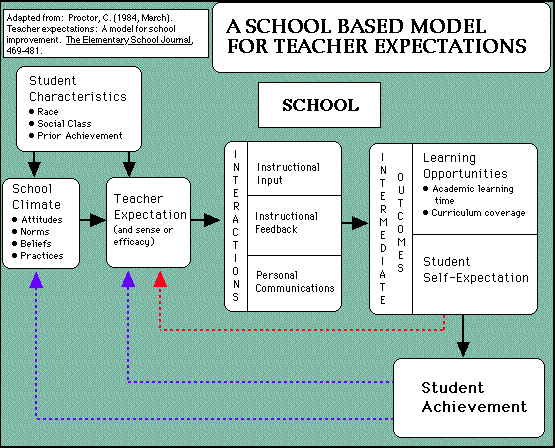
TEACHER EFFICACY
Citation: Huitt, W. (2000, August). Teacher efficacy. Educational Psychology Interactive. Valdosta, GA: Valdosta State University. Retrieved [date], from http://www.edpsycinteractive.org/topics/teacher/tcheff.html
Return to | Teacher Characteristics | EdPsyc Interactive: Courses |Home Page |
Proctor (1984) developed a model of the teaching/learning process that highlights the importance of teacher expectations for student learning. This model describes the variables or factors of schools and classrooms thought to be under the influence of educators.

In the early years of schooling, where teacher expectations are not yet based on documented performance (or performance can change dramatically from one year to the next), it appears that teacher expectations can produce achievement variations among stude nts.
As children progress into later childhood and adolescence, it appears that teacher expectations generally sustain, solidify, and therefore magnify, preexisting achievement differences.
Ashton (1984) reviewed research that shows there are two components to teacher expectations:
The term "teacher efficacy" has replaced the term of "teacher expectations." Ashton reports there are 8 dimensions to the development of teacher efficacy.
|
|
| 1. A sense of personal accomplishment | The teacher must view the work as meaningful and important. |
| 2. Positive expectations for student behavior and achievement | The teacher must expect students to progress. |
| 3. Personal responsibility for student learning | Accepts accountability and shows a willingness to examine performance. |
| 4. Strategies for achieving objectives | Must plan for student learning, set goals for themselves, and identify strategies to achieve them. |
| 5. Positive affect | Feels good about teaching, about self, and about students. |
| 6. Sense of control | Believes (s)he can influence student learning. |
| 7. Sense of common teacher/student goals | Develops a joint venture with students to accomplish goals. |
| 8. Democratic decision making | Involves students in making decisions regarding goals and strategies. |
Links to Self-efficacy Instruments
References:
| Internet Resources | Electronic Files |
Return to: